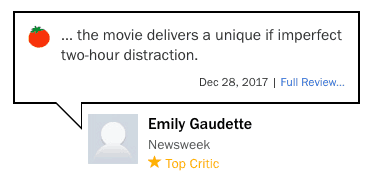Storytelling
Content Marketing Frees Writers From the Hot Take Machine
When I was an arts and culture reporter at Newsweek, an editor once overheard me in the kitchen talking to a friend from another department. I had recently watched a press screener of the Will Smith fantasy-action movie Bright, which was about to hit Netflix. Though I knew it was technically a bad movie, I was all hyped up on the way it portrayed orcs. (Previous films for orc enthusiasts include The Lord of the Rings and Warcraft.) Even though my praise was hyperbolic, my editor asked me to write a positive review of the film.
What could I have done as a new reporter at a publication? I wrote the thing, focusing mainly on the fantastical creatures and ignoring the fact that the movie’s plot, production design, and dialogue were all pretty terrible. Perhaps because I was the only writer to give Bright a good review, that hot take became my first Tomato-approved review on Rotten Tomatoes. To the rest of the world, I was suddenly the only person who enjoyed Netflix’s ridiculous movie. But a positive take on Bright wasn’t exactly the hill I wanted to die on.

Over the years, I’ve been asked to generate fiery opinions on a lot of inane topics. Many media companies still capitalize on knee-jerk emotions and reactionary op-eds. In the interest of generating these hot takes for site traffic, I’ve publicized my feelings about everything from political commentators to convicted murderers, and I admit that I’ve found the rhythm of the hot take cycle addictive.
On very rare occasions, an editor gave me the night to mull over my opinion and flesh out an argument. But 99 percent of the time, my spicy opinions were online just a few hours after I got an assignment. That’s not great for me, because after some time passes, my immediate reactions evolve. I’m still hoping some of my hot takes from 2014 will fade into the abyss of SERP #4. It’s also not great for publications that want to develop a credible relationship with readers over time.
Every once in a while, I’ll see a “hot take” article go online that seems to serve no purpose other than poking a publication’s target audience in the eye, which stirs up debate and generates clicks. In March, io9 published a blog post supporting director Zack Snyder’s assertion that Batman should murder innocents in movies and comics. Fans online were quick to point out that Snyder doesn’t know Batman lore very well. By responding too fast and taking the less informed side of the debate, io9 looked a little foolish.
A writer’s reprieve
I don’t often blame the contributors behind hot takes. Hot takes (and bad takes) are just a symptom of a broken media system. Most editors are hungry for people to either pan or praise, so there’s not a lot of room for measured, nuanced, longform content.
Although a ton of reactionary writing is well crafted with blistering prose, most of it dies soon after it appears online. Perhaps unsurprisingly, The New York Times consistently does this well, via Caity Weaver’s “Wait…” column. But most other places will find that as the takes get hotter, the lifespan of content freezes up quicker.
The good news is that content marketing pushes back on contrarian traffic-chasing, including hot takes and hate clicks. Brands that use content marketing are entering the media landscape unencumbered by the industry’s worst practices. They can cherrypick strategies that work (dynamic social packaging, embracing the freelance workforce) and leave other practices, like hot takes, behind. Content marketing works best when brands publish evergreen editorial work that’s both entertaining and educational. Remember, content should either make your audience’s life or jobs better. Anything without a meaningful purpose is useless to you, including hot takes.
That’s not to say digital marketers can’t express their opinions. It just doesn’t behoove a brand to publish a blog post that’s only intended to attract readers for a day. Imagine if Netflix started a blog in 2000 only to fill it with hot takes about movies and shows. Instead of fostering its reputation for being a “something for everyone” streaming platform, Netflix might have watched its brand voice go off the rails after too many extreme reactions.
Marketers tend to think of ROI holistically, analyzing data on their content beyond pageviews. They focus on metrics like email subscribers, time spent on site, and leads. Hot takes generate flash-in-the-pain surges in site traffic, and it’s difficult to build a sustainable, attractive brand using volatile viewpoints.
Content marketing, by virtue of being a slower industry than news media, is an oasis for writers stuck churning out takes. Brands are slowly becoming more comfortable investing in feature reporting, deep explainers, and the occasional cool-headed opinion piece. You know, the kind of writing we can be proud of.
Get better at your job right now.
Read our monthly newsletter to master content marketing. It’s made for marketers, creators, and everyone in between.




